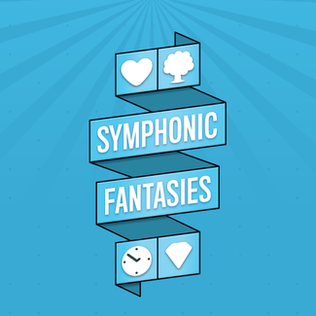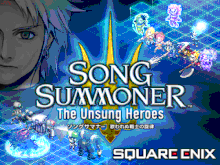
Final Fantasy IV, titled Final Fantasy II in its initial North American release, is a 1991 role-playing video game developed and published by Square for the Super Nintendo Entertainment System. The fourth main installment of the Final Fantasy series, the game's story follows Cecil, a dark knight, as he tries to prevent the sorcerer Golbez from seizing powerful crystals and destroying the world. He is joined on this quest by a frequently changing group of allies. Final Fantasy IV introduced innovations that became staples of the Final Fantasy series and role-playing games in general. Its "Active Time Battle" system was used in five subsequent Final Fantasy games, and unlike prior games in the series, IV gave each character their own unchangeable character class — although at a few points in the story, a dark knight will choose the path of a paladin, or a summoner will evolve to a new tier of spellcasting.

Final Fantasy Adventure, known in Japan as Seiken Densetsu: Final Fantasy Gaiden or simply Seiken Densetsu, and later released in Europe as Mystic Quest, is a 1991 action role-playing game developed and published by Square for the Game Boy. It is a spin-off of the Final Fantasy series and the first game in the Mana series.

The iPod is a discontinued series of portable media players and multi-purpose mobile devices that were designed and marketed by Apple Inc. from 2001 to 2022. The first version was released on November 10, 2001, about 8+1⁄2 months after the Macintosh version of iTunes was released. Apple sold an estimated 450 million iPod products as of 2022. Apple discontinued the iPod product line on May 10, 2022. At over 20 years, the iPod brand is the longest-running to be discontinued by Apple.

Square Enix Holdings Co., Ltd. is a Japanese multinational holding company, video game publisher and entertainment conglomerate. It releases role-playing game franchises, such as Final Fantasy, Dragon Quest, and Kingdom Hearts, among numerous others. Outside of video game publishing and development, it is also in the business of merchandise, arcade facilities, and manga publication under its Gangan Comics brand.

Cloud Strife is a character in the media franchise Compilation of Final Fantasy VII by Square Enix. He is the protagonist of the role-playing video games Final Fantasy VII (1997), Final Fantasy VII Remake (2020) and Final Fantasy VII Rebirth (2024) and the animated film Final Fantasy VII: Advent Children (2005), and appears in several other instalments in the wider Final Fantasy series. He has also appeared in other media, such as the Kingdom Hearts series by Square Enix and Disney and the Super Smash Bros. series by Nintendo.

Final Fantasy XII is a 2006 role-playing video game developed and published by Square Enix. The twelfth main installment of the Final Fantasy series, it was first released for the PlayStation 2 in March 2006. It introduced several innovations to the series: an open world; a seamless battle system; a controllable camera; a customizable "gambit" system, which lets the player control the artificial intelligence (AI) of characters in battle; a "license" system, which determines what abilities and equipment can be used by characters; and hunting side quests, which allows the player to find and defeat increasingly difficult monsters in the game's open world. Final Fantasy XII also includes elements from previous games in the series, such as Chocobos and Moogles.

Dragon Quest VIII: Journey of the Cursed King is a 2004 role-playing video game developed by Level-5 and published by Square Enix for the PlayStation 2. It was released in Japan and North America in November 2005, and in PAL regions in April 2006. It is the eighth installment of the Dragon Quest series and it is the first English version of a Dragon Quest game to drop the Dragon Warrior title. A version of the game for Android and iOS was released in Japan in 2013 and worldwide in 2014, with a version for Nintendo 3DS releasing later in 2015 in Japan and 2017 globally.
Hanjuku Hero is a Japan-exclusive series of real-time strategy video games. It is directed by Takashi Tokita and published by Square Enix. The series contains four main titles and a spin-off game. The main titles are Hanjuku Hero (1988), Hanjuku Hero: Aa, Sekaiyo Hanjukunare...! (1992), Hanjuku Hero Tai 3D (2003), and Hanjuku Hero 4: 7-Nin no Hanjuku Hero (2005). The spin-off is a Nintendo DS game called Egg Monster Hero (2005), which is a role-playing game with an emphasis on touch-based gameplay. The series is known for its humor and is centered on Lord Almamoon, the protagonist who must save his country from danger in each game.

Final Fantasy Type-0 is a 2011 action role-playing game developed and published by Square Enix for the PlayStation Portable (PSP). Released in Japan on October 27, 2011, Type-0 is part of the Fabula Nova Crystallis subseries, a set of games sharing a common mythos which includes Final Fantasy XIII and XV. The gameplay, similar to Crisis Core: Final Fantasy VII, has the player taking control of characters in real-time combat during missions across Orience. The player also engages in large-scale strategy-based battles on the world map, and has access to a multiplayer option during story missions and side quests.
Yusuke Naora is a Japanese video game art director and character designer who worked for Square Enix. A former member of Toaplan, Naora served as the art director for several Final Fantasy and Compilation of Final Fantasy VII titles. He also served as the producer of the Code Age franchise. On October 1, 2016 he announced on Twitter that he had left the company, but would continue to contribute to Square Enix games as a freelancer.
The Mana series, known in Japan as Seiken Densetsu, is a role-playing video game series from Square Enix, created by Koichi Ishii. The series began as a handheld side story to Square's flagship franchise Final Fantasy, although most Final Fantasy-inspired elements were subsequently dropped, starting with the second installment, Secret of Mana. It has since grown to include games of various genres within the fictional world of Mana. The music of the Mana series includes soundtracks and arranged albums of music from the series, which is currently composed of Final Fantasy Adventure and its remake Sword of Mana, Secret of Mana, Trials of Mana, Legend of Mana, Dawn of Mana, Children of Mana, Friends of Mana, Heroes of Mana, Circle of Mana, and Rise of Mana. Each game except for Friends and Circle has produced a soundtrack album, while Adventure has sparked an arranged album as well as a combined soundtrack and arranged album, Legend of Mana has an additional promotional EP, and music from Secret and Trials were combined into an arranged album. For the series' 20th anniversary, a 20-disc box set of previously-released albums was produced, as well as an album of arrangements by Kenji Ito, composer for several games in the series.

The World Ends with You is an action role-playing game co-developed by Square Enix and Jupiter for the Nintendo DS. Set in the modern-day Shibuya shopping district of Tokyo, The World Ends with You features a distinctive art style and urban fantasy elements inspired by Shibuya and its youth culture. Development was inspired by elements of Jupiter's previous handheld game, Kingdom Hearts: Chain of Memories. It was released in Japan in July 2007, and in PAL regions and North America in April 2008. Later, an enhanced port by h.a.n.d. for mobile devices was released in 2012 under the title The World Ends with You: Solo Remix, while another enhanced port for the Nintendo Switch was released worldwide in 2018 under the title The World Ends with You: Final Remix.

Dissidia Final Fantasy is a 2008 fighting game developed and published by Square Enix for the PlayStation Portable as part of the campaign for the Final Fantasy series' 20th anniversary. It was released in Japan on December 18, 2008, in North America on August 25, 2009, and in Australia and Europe in September. It was then re-released in Japan, based on the North American version, as Dissidia Final Fantasy: Universal Tuning, on November 1, 2009.

Crystal Defenders is a set of two tower defense video games developed and published by Square Enix. The games use the setting of Ivalice and design elements from Final Fantasy Tactics A2: Grimoire of the Rift, forming part of the wider Final Fantasy franchise. The games feature a selection of characters sporting Final Fantasy-based character classes, and play out tower defense scenarios against recurring series of monsters. The first game in the series is Crystal Guardians, which was released in three parts for Japanese mobile phones in 2008. It was adapted for iOS later that year as Square Enix's first game for the platform, and renamed Crystal Defenders. Under that name, the game was also released between 2009 and 2011 for Android, Xbox Live Arcade, WiiWare, and PlayStation 3 and PlayStation Portable via the PlayStation Store. It was re-released with graphical improvements for iOS as Crystal Defenders Plus in 2013. A sequel, Crystal Defenders: Vanguard Storm, was released for iOS in 2009.

Tidus is a fictional character in Square Enix's video game series Final Fantasy and the main protagonist of the 2001 role-playing video game Final Fantasy X. A 17-year-old athlete from the city of Zanarkand, he is transported to the world of Spira after Sin destroys Zanarkand. Shortly after arriving there, Tidus meets the summoner Yuna and her guardians and joins them on a pilgrimage to kill Sin after learning that it is his missing father, Jecht. Tidus has appeared in other video games, including the Final Fantasy X sequel X-2, where he can be recruited as a playable character in the international version. He also appears as a child in the Kingdom Hearts series and in various Square Enix crossover games.
Unsung Heroes is a North Korean film series.

Myth: The Xenogears Orchestral Album is an arranged soundtrack to Square Enix's role-playing video game Xenogears. It is the third soundtrack to the game, after Xenogears Original Soundtrack and Creid, another arranged album, both released in 1998. Myth was composed by the game's composer Yasunori Mitsuda and arranged by Mitsuda, Youki Yamamoto, Sachiko Miyano, and Natsumi Kameoka. The album contains 14 tracks, including a song performed by the Irish singer Joanne Hogg, and has a length of 51:33. The orchestration was performed by the Bulgarian Symphony Orchestra, conducted by Yamamoto. The album was announced in October 2010, and was released on February 23, 2011 by Square Enix. A vinyl record version of the album was released on April 1, 2011, consisting of six tracks from the full album.

Symphonic Fantasies: Music from Square Enix was an award-winning symphonic tribute concert originally held in Cologne, Germany on September 12, 2009, at the Cologne Philharmonic Hall featuring video game music from Japanese game developer Square Enix. The concert featured symphonic movements based on the Kingdom Hearts series, Secret of Mana, the Chrono series, and the Final Fantasy series. It was produced and directed by Thomas Böcker, with arrangements provided by Finnish composer and musician Jonne Valtonen with assistance by Roger Wanamo. Due to overwhelming demand, a second concert was added at the König-Pilsener-Arena in Oberhausen, on September 11, 2009. Both performances were by the WDR Radio Orchestra Cologne and the WDR Radio Choir Cologne under conduction from Arnie Roth, with guest performers Rony Barrak and Benyamin Nuss joining the orchestra. Symphonic Fantasies was broadcast over radio on the WDR4 station and streamed live video online.

Dissidia Final Fantasy NT is a fighting game with action role-playing elements developed by Koei Tecmo's Team Ninja and published by Square Enix for PlayStation 4 and Windows.
















